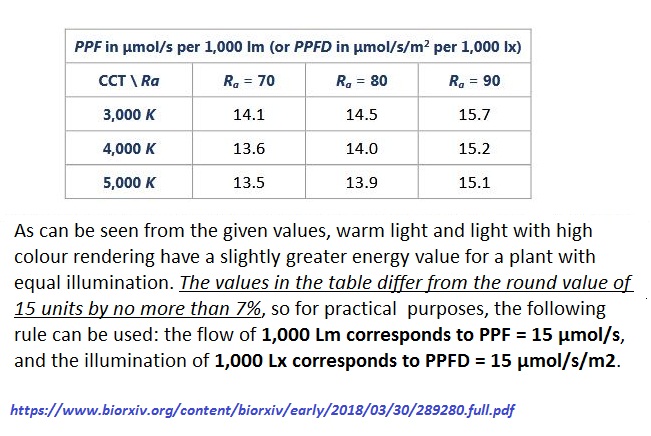pyrocumulus wrote: ↑Sat Oct 23, 2021 3:23 am
Hello PeteR_1,
I’ve read through this forum and am trying to condense all of this great information into something I can use for my particular situation. My interest is in quantifying the light available to my orchids and succulents. My primary goal is to get a reasonably accurate, repeatable measurement of PPFD. It would be interesting to get intensity, %RGB, etc. as well, but they are not as important to me.
It looks like the TCS34715FN sensor is no longer made and difficult to find. The TCS34725 sensor referenced here (specifically the Adafruit breakout board, PN 1334) looks like it is ready to go and already has an Arduino library available. It appears there is no need to remove the on-board LED because it can be disabled in hardware.
I don’t have a calibrated light intensity meter, nor do I have a lux to PPFD conversion factor for my particular LED lights. I bought some Barrina 2 ft grow lights but I don’t think Barrina provides conversion factors for their lights. The Amazon page for these lights has a graphic with PAR at various configurations but I don’t really trust that (
https://www.amazon.com/Barrina-4-Pack-L ... B09H6K78MX).
I thought I could simply extend Adafruit’s TCS34725 breakout board Arduino library to calculate PPFD, but now I’m confused about their initial calculations (
https://github.com/adafruit/Adafruit_TC ... 34725.cpp)), specifically line 417:
Code: Select all
illuminance = (-0.32466F * r) + (1.57837F * g) + (-0.73191F * b);
Where did those coefficients come from?
I read through the ams DN40 document and understand the luminance code you posted on Feb 19, 2021. I see that the PAR equation comes from the MultispeQ article, but isn’t that specific to the TCS34715FN sensor?
I also don’t know where the CPAR_cf comes from in your code.
Code: Select all
float cpar = (cdata * 0.00238663) * lens_cf;
Is 0.00238663 the lux → PPFD conversion factor for your particular lights?
Also, can you recommend a source for a ~15% translucent diffuser lens? I have seen Acrylite sheets for sale but not a lens.
Thanks!
Hello,
The TCS34725 is a TCS34715 with a built-in UV/IR cut filter, the cut filter range is 'narrow' compared to PAR range, but it can and has been calibrated to PAR...
The Adafruit 'coefficients' come from the TCS34xx Document...
https://ams.com/documents/20143/36005/T ... 7a1e377102
AMS TCS34725 related Documents...
https://ams.com/TCS34725#tab/documents
Some of the Adafruit Library's calculations have inherent errors that directly affect PAR and %RGB, that is why I haven't used them and opted for the simpler code...
The "CPAR_Cf" (Clear Data Only PAR factor) was an exercise for...
viewtopic.php?p=24937#p24937
It was used / trialed as a comparison, but is not consistent nor reliable for measuring higher intensity light sources due to 'Saturation' errors, multiple Calibration errors and has been removed from the code.
There are no "Lenses" to recommend, I just cut circles from 1/8" and 1/4" White Translucent Acrylic Sheets, stacked in multiple layers the measured Lux values are used to get the % Transmittance factors, as noted in previous posts and below.
PAR is directly related to LUX for every Visible Light Source. If you are using fixed light spectrum
Lux Sensor with appropriate correction factors would provide a simpler PAR only meter and they come with diffusion lens. Surprisingly six (6) BH1750FVI sensors, bare without the Lenses and from two different sources measure within 2% of a calibrated Lux Meter. Only the Lens and PAR Coefficients are required for relatively accurate measurements, no actual Lux meter calibration was needed, they appear to be "Factory Calibrated",
but require the Lens Coefficient for accurate Lux measurements
BH1750FVI Lux Sensor...
https://www.aliexpress.com/item/3301179 ... 4c4d1K5MYJ
Lens Correction Factor is easily acquired with a properly operating TCS34725 or BH1750 sensor.
1. Setup a fixed light source (any 2700 - 5000K household bulb will work) and fixed distance between the bare sensor, measure and record the result.
2. Place the Lens over the sensor without changing the distances, measure and record the results.
3. Calculate the % Transparency by dividing result #2 by result #1 to get a decimal result (Percentage when multiplied by 100).
4. Calculate the Lens Correction Factor by dividing 1 (one) by the decimal result (or 100% / xx% Transparency).
For Example; [2000 (#2) / 4000 (#1) = 0.5 ... 1 / 0.5 = 2.0 Cf]
As previously noted along with the installed Lens Coefficient / Correction Factor only the PAR Coefficient / Correction Factor ( float cf_par =
0.015; ) need to be changed for any specific measured White Light source...
viewtopic.php?f=15&t=5756

Code: Select all
//BH1750FVI with 50% light transmittance Cosine Correction Dome
// Serial Print Only. No Local Display
#include <Wire.h>
#define Addr 0x23
void setup()
{
Wire.begin();
Serial.begin(9600);
Wire.beginTransmission(Addr);
Wire.write(0x01);
Wire.endTransmission();
Wire.beginTransmission(Addr);
Wire.write(0x10);
Wire.endTransmission();
delay(300);
}
void loop()
{
unsigned int data[2];
Wire.requestFrom(Addr, 2);
if(Wire.available() == 2)
{
data[0] = Wire.read();
data[1] = Wire.read();
}
delay(300);
float luminance = ((data[0] * 256) + data[1]) / 1.20;
float cf_lux = 2.0; // 50% transmittance Dome
float cf_par = 0.015; // PAR factor 4000K 90 CRI LED
float lux = luminance * cf_lux;
float par = lux * cf_par;
Serial.print("LUX :");
Serial.print(lux);
Serial.println(" Lm/m2");
Serial.print("PPFD :");
Serial.print(par);
Serial.println(" umol/s-m2");
delay(1000);
Good luck.

